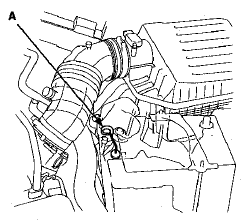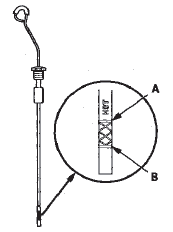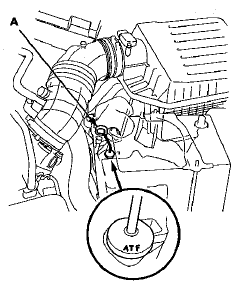 Honda Accord: ATF Level Check
Honda Accord: ATF Level Check
NOTE: -Keep all foreign particles out of the transmission.
-Check the ATF level within 60—90 seconds after turning the engine off.
-Higher ATF level may be indicated if the radiator fan comes on twice or more.
1. Park the vehicle on level ground.
2. Warm up the engine to normal operating temperature (the radiator fan comes on), and turn the engine off.
3. Remove the ATF dipstick (yellow loop) (A) from the transmission, and wipe it with a clean cloth.

4. Insert the dipstick into the transmission.
5. Remove the dipstick, and check the ATF level. It should be between the upper mark (A) and the lower mark (B).

6. If the ATF level Is below the lower mark, check for fluid leaks at the transmission, the ATF cooler hoses, the line joints, and the cooler lines. If a problem is found, fix it before filling the transmission with ATF.
NOTE: If the vehicle is driven when the ATF level is below the lower mark, one or more of these symptoms may occur: -Transmission damage.
-Vehicle does not move in any gear.
-Vehicle accelerates poorly, and flares when starting off in D and R.
-The engine vibrates at idle.
7. If the level is above the upper mark, drain the ATF to proper level (see step 3 on page 14-192).
NOTE: If the vehicle is driven when the ATF level is above the upper mark, the vehicle may creep forward in N, or have problems shifting.
8. If necessary, fill the transmission with ATF through the dipstick hole to bring the fluid level between the upper mark and the lower mark of the dipstick. Do not fill the fluid above the upper mark. Always use Honda ATF-Z1 automatic transmission fluid (ATF). Using a non-Honda ATF can affect shift quality.
9. Insert the dipstick (A) back into the transmission with the letters "ATF" pointing toward the front of the vehicle.

 ATF Temperature Sensor
Test/Replacement
ATF Temperature Sensor
Test/Replacement
1. Raise the vehicle on a lift, or apply the parking brake,
block both rear wheels, and raise the front of the
vehicle. Make sure it is securely supported.
2. Remove the splash shield.
3. Disc ...
 ATF Replacement
ATF Replacement
NOTE: Keep all foreign particles out of the transmission.
1. Park the vehicle on level ground.
2. Warm up the engine to normal operating temperature
(the radiator fan comes on), and turn the en ...
See also:
Cylinder Head Inspection for
Warpage
1. Remove the cylinder head (see page 6-76).
2. Inspect the camshaft (see page 6-84).
3. Check the cylinder head for warpage. Measure along
the edges, and three ways across the center.
- If ...
Installing a Child Seat with LATCH
Your vehicle is equipped with
LATCH (Lower Anchors and
Tethers for CHildren) at the outer
rear seats.
The lower anchors are located
between the seat-back and seat
bottom, and are to be used ...
